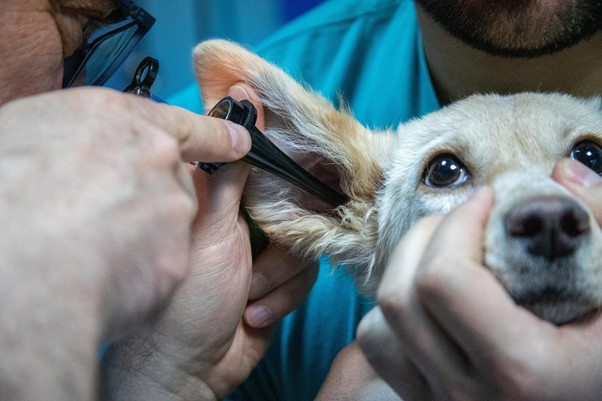Bladder Stones in Dogs
- Last updated on April 18, 2023
- By: Caroline Stowe
As a dog pet owner, it is important to be aware of the risks associated with bladder stones in dogs.
Bladder stones are incredibly common in dogs but can be very painful for your pet. They are small mineral deposits made up of compounds such as calcium oxalate and struvite that form within a dog’s urinary tract.
Unfortunately, bladder stones can lead to serious health issues if left untreated. Let’s dive into what bladder stones are, the risk factors associated with them, and how you can keep your dog healthy and safe.

What Are Bladder Stones?
Bladder stones (also known as uroliths) are mineral deposits that form in the urinary tract of animals.
These stones vary in size and shape and can be composed of various substances such as calcium oxalate, struvite, uric acid, cystine, or silicate.
Types of Bladder Stones in Dogs
Calcium Oxalate Stones
Calcium oxalate stones are one of the most common types of bladder stones in dogs and can be made up of either calcium oxalate monohydrate (COM) or calcium oxalate dihydrate (COD).
They form when there is an excess amount of calcium in the urine.
Struvite Stones
Struvite stones are made up of magnesium ammonium phosphate and form when there is an excess amount of ammonia in the urine. They can also form if the pH of the urine is too high.
Uric Acid Stones
Uric acid stones form when the levels of uric acid in the urine are too high.
Cystine Stones
Cystine stones form when there is an excess of cysteine amino acid in the urine. They are quite rare and are usually only seen in breeds such as Cocker Spaniels, Miniature Schnauzers, and Lhasa Apsos.
Symptoms of Bladder Stones in Dogs
Blood in the Urine
This is one of the most common symptoms of bladder stones in dogs and may present itself as either visible blood or as microscopic traces that can be detected with a urinalysis.
If your pet is having difficulty passing urine, check for any discoloration in the urine, as this could indicate the presence of blood.
Frequent Urination
If your pet is urinating more frequently than usual or straining to pass urine, it could be a sign of bladder stones.
As the stones get larger, they can start to block the urinary tract and make it harder for your pet to pass urine normally.
Difficulty Passing Urine
If your pet is having difficulty passing urine, it could be a sign of bladder stones. The stones can block the urinary tract and make it harder for your pet to pass urine normally.

Pain When Urinating
If you notice that your pet is exhibiting signs of pain when urinating such as excessive licking or vocalizing, it could be a sign of bladder stones.
Causes of Bladder Stones in Dogs
Bladder stones are most commonly caused by an imbalance in the urine’s pH and mineral levels. Other factors such as genetics, age, diet, and environment can also contribute to the formation of bladder stones.
Diet
An unbalanced diet can lead to the formation of bladder stones in dogs. It is important to feed your pet a high-quality, balanced diet that contains all the essential nutrients and minerals they need. High-protein diets can increase the risk
This will help keep their urine pH and mineral levels in balance, which can reduce the risk of bladder stone formation.
Genetics
Some breeds of dogs are more prone to developing bladder stones than others. These breeds include the English bulldog, Dalmatian, Miniature Schnauzer, and Lhasa Apso.
Age
Bladder stones are more common in older dogs due to the changes that occur in their urinary tract as they age.
As dog’s age, their bladder muscles become weaker and less efficient at contracting and emptying, allowing minerals to accumulate in the urine which leads to bladder stone formation.
In addition, older dogs often have reduced kidney function which can also contribute to the formation of bladder stones.
Weight
Overweight dogs may be at an increased risk of developing bladder stones due to a variety of factors. Firstly, obesity can lead to an increase in the amount of calcium and other minerals in the urine.
This is because fat cells secrete hormones that cause the kidneys to release more calcium and other minerals into the urine.
Environment
The environment in which your pet lives can also contribute to the formation of bladder stones.
If your dog is living in an environment that has high levels of humidity, unsanitary conditions, or exposure to pollutants, it may be more prone to developing bladder stones due to the presence of bacteria and minerals in the air.
How to Diagnose Bladder Stones in Dogs?
Urine Test
The most common way to diagnose bladder stones in dogs is to perform a urine test, which can detect microscopic traces of blood and other abnormalities that suggest the presence of bladder stones.
This test is easy to perform and can be done at your vet’s office or at a laboratory.
Ultrasound
An ultrasound can also be used to diagnose bladder stones in dogs. This imaging test uses sound waves to create a picture of the bladder and other organs, allowing your vet to identify any abnormalities that may indicate the presence of bladder stones.
X-Ray
An x-ray is another way to diagnose bladder stones in dogs. It is a non-invasive test that can help your vet identify the size and shape of bladder stones, as well as any other abnormalities in the urinary tract.
CT Scan
A CT scan is an advanced imaging technique that can provide more detailed images of the bladder and other organs than an x-ray or ultrasound.
It is also more accurate and can help your vet identify the exact location of bladder stones.
Treatment for Bladder Stones in Dogs
The treatment for bladder stones will vary depending on the size, location, and composition of the stones. Some of the most common treatment options include:
Diet Change
A diet change can often help to prevent bladder stones from forming or reoccurring.
This involves switching your pet’s food to one that has higher levels of fiber and lower levels of protein, as well as providing them with plenty of fresh water throughout the day.
Learn to treat bladder stones in dogs by clicking the link below.
Medication
Depending on the type of bladder stone, a veterinarian may prescribe medications to help break down the stones and make them easier to pass through the urinary tract.
Fluid Therapy
This involves providing your pet with extra fluids in order to flush out any remaining small stones or debris.
The vet may also recommend giving your pet a special diet that is low in minerals, as this can help reduce the risk of bladder stones forming.
Surgery
Surgery is one of the most common treatments for bladder stones in dogs. This involves removing the stones through an incision in the bladder wall.
During the procedure, a veterinarian will use special instruments to break up and remove the stones from the bladder. The vet may also need to perform a biopsy to determine what type of stone is present.
How to Prevent the Formation of Bladder Stones in Your Dog
Feed a Balanced & Nutritious Diet
A balanced and nutritious diet is essential for good health and well-being, and this includes bladder stone prevention.
A diet that is low in minerals such as calcium, magnesium, phosphorus, and sodium can help reduce the formation of bladder stones. Look for diets that are high in fiber, have a moderate fat content, and are low in proteins.
Ensure Your Dog Gets Enough Exercise
Exercise helps to keep the muscles of the bladder active and can help prevent the formation of stones. Make sure your pet has plenty of opportunities to run and play throughout the day.
Practice Good Hygiene
Keeping your pet clean and free from bacteria can help to reduce the risk of bladder stones forming. Make sure to bathe your dog regularly and keep their bedding clean and dry.

Drink Plenty of Water
Make sure they drink plenty of water throughout the day; this helps reduce their chances of developing any type of urinary tract infection or blockage which could lead to the development of a bladder stone.
Drinking enough water throughout the day helps keep the bladder flushed of any potential stone-forming minerals.
Regular Vet Visits
Making regular vet visits is important, as they can identify any early signs of bladder stones and provide treatment accordingly. Vets may also recommend special diets or medications that can help reduce the risk of bladder stones.
Conclusion
In conclusion, while bladder stones may seem like a scary prospect for pet owners it’s important to note that there are steps you can take to protect your pup from developing this condition such as feeding them a balanced diet low in protein and encouraging them to drink plenty of water throughout the day.
In addition, regular checkups with your veterinarian allow for early detection should any issues arise allowing for quick treatment options before things get serious!
Taking these simple steps will help keep your beloved canine companion healthy and safe!
-
Author: Caroline Stowe
- Updated on April 18, 2023
Disclaimer: This article doesn’t intend to replace professional veterinary advice, nor should it be used as a substitute for veterinary services, diagnosis, or treatment. The content on this website, including information and opinions expressed herein, are intended for general informational purposes only. In case you have concerns or questions regarding your dog’s health and diet requirements, please consult your veterinarian before doing anything that might affect it.
DogPetGuide.com and the writer are not responsible or liable for any damage, liability, costs, or claims arising from any possible consequences of the reader’s action after reading this article.




